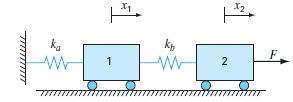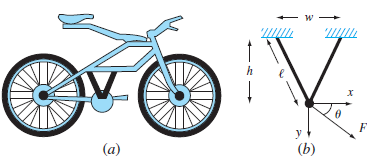Recent interest in competitive and recreational cycling has meant that engineers have directed their skills toward the
Question:
Recent interest in competitive and recreational cycling has meant that engineers have directed their skills toward the design
Figure P16.32
Two frictionless masses connected to a wall by a pair of linear elastic springs.

Figure P16.33
(a) A mountain bike along with (b) a free-body diagram for a part of the frame.

And testing of mountain bikes (Fig. P16.33a). Suppose that you are given the task of predicting the horizontal and vertical displacement of a bike bracketing system in response to a force. Assume the forces you must analyze can be simplified as depicted in Fig. P16.33b. You are interested in testing the response of the truss to a force exerted in any number of directions designated by the angle u. The parameters for the problem are E = Young’s modulus 2 × 1011 Pa, A = cross-sectional area = 0.0001 m2, w = width = 0.44 m, l = length 5 0.56 m, and h 5 height 5 0.5 m. The displacements x and y can be solved by determining the values that yield a minimum potential energy. Determine the displacements for a force of 10,000 N and a range of u’s from 08 (horizontal) to 908 (vertical).
Step by Step Answer:

Numerical Methods for Engineers
ISBN: 978-9352602131
7th edition
Authors: Steven C. Chapra, Raymond P. Canale





